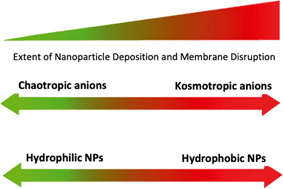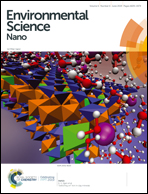Interactions between polystyrene nanoparticles and supported lipid bilayers: impact of charge and hydrophobicity modification by specific anions†
Abstract
Understanding how surface forces and aqueous ions influence the interactions between nanoparticles (NPs) and supported lipid bilayers (SLBs) is central to all disciplines interested in studying the nano–bio interface. A prevailing understanding is that cationic NPs have higher penetrating capability across cell membranes. In contrast, we report in this study that anionic polystyrene NPs are capable of binding and penetrating SLBs formed by zwitterionic DOPC when charge and hydrophobicity work in concert with specific anions. The preferential deposition of anionic NPs onto the bilayer is rationalized electrostatically by considering the slightly positive charge of DOPC. In addition to charge, NP hydrophobicity played an important role in the subsequent penetration of anionic NPs into SLBs. The extent of NP deposition was modulated by chaotropic anions (NO3−). This study also demonstrates the promise of using a novel combination of surface sensitive techniques, quartz crystal microbalance with dissipation monitoring (QCM-D) and surface-enhanced infrared absorption spectroscopy (SEIRAS), to extend the current understanding of NP–SLB interactions to the molecular scale.



 Please wait while we load your content...
Please wait while we load your content...
